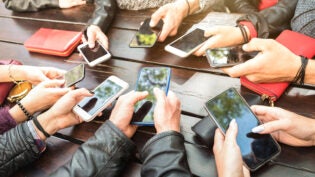
As a general proposition, I think it’s fair to say that marketing is going mobile. There is something organic and seamless about the relationships we have with our mobile devices. These devices have become highly relevant to our daily lives precisely because they deliver convenience, simplicity, and proximity.
Here’s what I mean. Mobile devices make our lives more convenient, and for most of us, convenience implies simplicity. Thanks to the increase in mobile-optimized websites and mobile apps, the path to discovery on mobile is continuously simplified. We’re able to resolve our needs and wants and digest information and entertainment with ease, navigating our way through numerous complex actions with a few taps of our fingers.
In many cases, this simplicity implies proximity (geo-spatial or online), which in turn gives rise to the idea of contextual relevance. Mobile device in hand, we want what we want when we want it. Whether looking for a place to eat, a hot (and affordable) new shirt, or a timely piece of advice or information, whoever provides the most simple and proximate solution will likely win our business (and, by extension, our allegiance). Proximity does not always mean geo-spatial; my solution may come online from across the globe. To be proximate, though, my solution must appear exactly where I am looking when I need or want it, or be provided by a brand or person that I value in some way.
In its essence, the very notion of mobile implies proximity in action.
Proximity in Action
The continued growth in mobile suggests there is a lot of action going on. According to Cisco’s Visual Networking Index Global Mobile Data Traffic Forecast Update reported in a recent Mashable post, consumer adoption of mobile is growing apace. In fact, Cisco predicts global mobile data traffic will increase 13-fold by 2017, with more than 10 billion mobile-connected devices by then.
Which leads me to the next point: we mobile-toting humans are essentially social creatures. Nowhere is this more evident than when one analyzes the mobile habits of the largest demographic group in history, the Millennials (Gen Y).
According to a whitepaper put out by The Center for Generational Kinetics, Bazaarvoice, and Kelton Research, the annual spending power of Millennials, now at over $200 billion, will eclipse Baby Boomers’ by 2017. Accounting for 25% of the US population, the Millennials (aka Generation Y) are estimated to be the largest consumer group in US history.
When looking for opinions about products to buy, the whitepaper noted that Millennials are 3X more likely than Boomers to turn to social channels. This notion is supported by data from recent (January 2014) polling conducted by Harris Interactive, which showed that 68% of 18-to-34-year-old social media users surveyed were at least somewhat likely to make a purchase after seeing a friend’s post.
The Generational Kinetics whitepaper also noted that, in addition to the opinions of friends and family, Millennials actively seek out feedback from strangers (especially those with product experience) as well as industry experts. In fact, more than 80% say user-generated content from people they don’t know influences what they buy and indicates brand quality, with 51% admitting it is actually more important than the opinions of their friends and family.
Thus, social media and local proximity are symbiotically linked to our mobile experience, creating a new marketing paradigm: social local mobile, or SoLoMo.
What is SoLoMo, Anyway?
From a marketing perspective, SoLoMo can be defined as the practice of targeting mobile consumers based on their current location with content or promotions designed to be shared via social networks.
Underpinning SoLoMo is the contextual relevance which springs from the organic interplay between social, local and mobile. A few stats from the Adobe 2013 Mobile Consumer Survey bear out this notion:
- 71% of respondents reported using their mobile device to access social media. This deep connection between social and mobile should come as no surprise when you consider that mobile users prefer visual, concise, and contextually relevant content.
- 70% of respondents reported using their mobile device to search for local information such as event times, maps, and reviews.
- Almost a third of respondents have checked in via a location service on their mobile device, and 30% of those people said they received an incentive to check in.
The importance of contextual relevance in SoLoMo is further underscored by the findings of a 2012 Nielson study on smartphone shopper activities, which found that 78% of mobile shoppers turn to their smartphones to find a store, 63% to check prices online, and 22% to comment on a purchase. Such data anecdotally suggest that “SoLoMo” apps which provide user-generated reviews and location-based offers significantly influence mobile consumers.
What Can Businesses Do to Prepare?
To prepare for this new SoLoMo marketing reality, businesses need to focus on providing 24/7 user experiences that address and resolve the wants and needs of their target audience but still reflect the goals and values of their organization. Companies with a brick-and-mortar presence need to ensure they are easily accessible when prospects are nearby. Whether it’s SMS Text Marketing, local SEO, local discounts and offers, geo-fencing, or location-specific daily deals, proximity creates top-of-mind awareness and drives conversion; each of these geo-local marketing techniques is most effective when executed with a SoLoMo mindset.
By employing the latest digital tactics and tools like responsive web design, interactive, multi-media content marketing, and real-time social media engagement, brands can at least come close to providing the anywhere, anytime, fully-integrated user experiences that today’s SoLoMo consumers are expecting to find as part of their intrinsic new reality.
This article was originally published by SyneCore
Published: February 25, 2014
2442 Views
2442 Views











